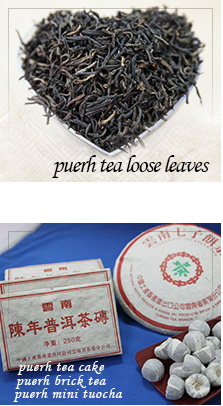Tea information


Ingredients
The territory of knowing Pu’erh tea is so profound. Pu’erh tea is a variety of fermented dark tea produced in Yuannan province, China. They are mainly from wild old arbor tea trees.
Pu’erh can be divided into two categories based on processing methods: raw tea and ripe tea. Raw Pu’erh is steam-pressed from Maocha (light green rough tea). An additional converting process called pile fermentation, also known as Wodui, makes raw tea into ripe tea. Wodui process is used to accelerate fermentation which allows fungal culture to properly oxidize. During this process, protein in the tea leaves can be broken-down into amino acid therefore produces Thearubigins and Theabrowns. Once Maocha is ripen thru Wodui, it is ready to be consumed after approximately two months. The aroma of ripe Pu’erh is smooth and sweet. Raw Pu’erh needs to be stored for many years and undergo natural aging process to achieve the right amount of fermentation.
Appearance
There are two types of Pu’erh tea based on their appearance: loose tea and pressed tea. Pressed tea, depending on the mold used, come in different shapes, such as bricks, bowls, and discs. The shape of the tea has different effects on the speed of fermentation, and of course the selling price varies as well.
Generally speaking, the drier the tea is, the more sensitive it is to humidity. Teas that have floral or light flavors, need special care when storing to avoid tea absorbing other scents or flavors in the environment.
Regions
Yunnan province produces vast majority of Pu’erh tea. Other regions like north part of Vietnam, Thailand, Burma and India also known to produce Pu’er. Just like wines, climate condition of the regions affects the flavors of their tea.
In deed, everyone has personal preference of tea. Tea varieties from all over the world all have their own flavors because they are grown in different weather and soil conditions. Come to Ming Shan, you can easily find a classic that suits your personal taste bud.
